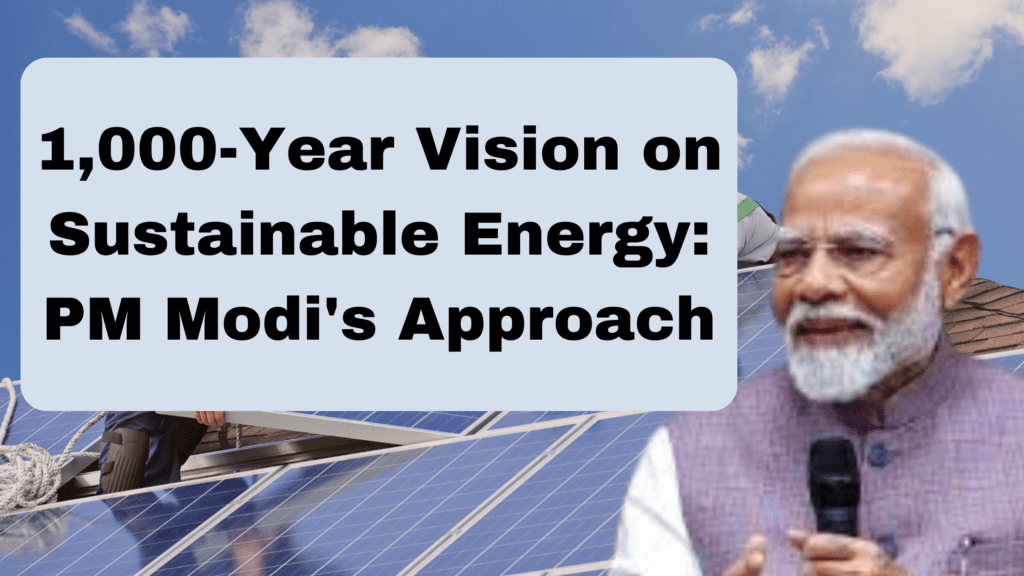1,000-Year Vision on Sustainable Energy: PM Modi's Approach
Introduction
At the 4th Global Renewable Energy Investor’s Meet in 2024, Prime Minister Narendra Modi unveiled a 1,000-year vision for sustainable energy. fulfilling India’s energy sustainability and self-sufficiency will require fulfilling this goal. India’s limited supply of gas and oil has led it to pursue renewable energy sources like solar, wind, nuclear, and hydropower. This would secure our energy future and enhance India’s reputation globally.
India's focus on sustainable energy
India is making tremendous progress in ensuring energy security. As more people become aware of the drawbacks of conventional energy sources and their negative environmental effects, India has prioritized renewable energy sources like solar, wind, nuclear, and hydropower. Given that India does not have substantial oil or gas reserves, Prime Minister Modi emphasized that the country is focusing on renewable energy sources, such as solar and wind power. In line with this, India has introduced initiatives like the Offshore Green Energy Policy. In order to help meet the country’s future energy needs, this program aims to promote the production of renewable energy in the coastal regions of the country.
Goals and Achievements
Prime Minister Modi also underlined India’s audacious objective of achieving 500 GW of renewable energy capacity by 2030. If India succeeds in this endeavor, the country’s energy sector will soar to new heights. India currently has 30 times more installed solar energy capacity than it did nine years ago, at 89.4 GW. Similarly, the potential for wind energy is 47.19 GW. This development will provide the country with energy security while also promoting environmental balance.
Global leadership in green energy
India is leading the G20 in the field of renewable energy. As per PM Modi, India is at the forefront of the global renewable energy scene. The best example of this is the International Solar Alliance (ISA), which was founded during COP21 by France and India. The main objective of ISA is to promote solar energy consumption and raise $1,000 billion in investment in this field by 2030. 99 countries are currently members of the ISA, of which 119 have signed. India is proud that it is now the world leader in green energy due to the location of the ISA headquarters.
Government Initiatives
The Indian government has implemented several important policies to promote green energy in recent years. For example, the Offshore Green Energy Policy has been implemented under the Vibrant Gas Funding Scheme, in which more than ₹7,000 crore will be invested. Furthermore, substantial investments are being made in the hydropower sector, with a target of 31,000 MW hydropower generation. The nation is taking this project seriously, as evidenced by the administration’s 100 days of emphasis on green energy.
Conclusion
With PM Modi’s 1,000-year sustainable energy plan, India will enjoy energy security and grow into a major global energy producer. If India is able to rank among the most developed countries in the world in the twenty-first century, it stands to earn a great deal. India will set the bar for development both nationally and globally, with a focus on renewable energy.
This blog has demonstrated India’s progress toward a sustainable future where major energy sources such as hydropower, wind, solar, and nuclear power are available. This idea inspires not just India but the whole world.
If you want to be part of this exciting journey toward sustainability, consider harnessing the power of solar energy for your home or business. Visit Thermosun today to explore our comprehensive solar solutions and take a step towards a greener future!
Frequently Asked Questions (FAQs)
1. What is India's 1,000-year Sustainable Energy Vision, and what are its main components?
Ensuring millennial energy security is the aim of India’s Sustainable Energy Vision. Its main components are nuclear energy, solar energy, wind energy, and hydropower. This goal would push India to become the world’s energy leader while also helping the environment.
2. What new policies and schemes has Prime Minister Modi launched in the field of green energy?
Prime Minister Modi initiated key policies such as the Offshore Green Energy Policy and the Vibrant Gas Funding Scheme. The government will invest ₹7,000 crore under the Offshore Green Energy Policy to develop renewable energy in coastal regions. Meanwhile, the Vibrant Gas Funding Scheme is designed to advance various other aspects of green energy.
3. What is India's target in the field of renewable energy by 2030, and what steps are being taken for this?
India’s target is to install 500 GW of renewable energy capacity by 2030. To achieve this target, the government is investing heavily in solar and wind energy. At present, India’s installed capacity of solar energy is 89.4 GW, while the capacity of wind energy is 47.19 GW. With these efforts, India is becoming a leader in renewable energy at the global level.
4. What is the International Solar Alliance (ISA), and what is its significance for India?
India and France jointly launched the International Solar Alliance (ISA) to promote solar energy and mobilize $1,000 billion in investments by 2030. With 99 member countries, ISA operates from its headquarters in India, showcasing India’s leadership in global energy initiatives.
5. How is India ahead of other countries in the field of green energy, and what are its implications?
India took the top rank by reaching the goals of the 2015 Paris Climate Agreement earlier than any other G20 nation. This accomplishment is making India a global leader in green energy investment and advancement. This would help maintain the natural equilibrium while also strengthening India’s economy.


